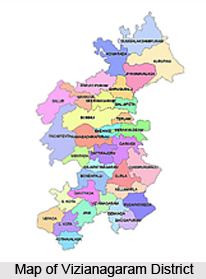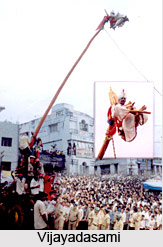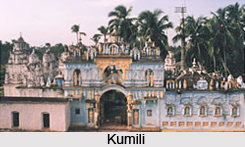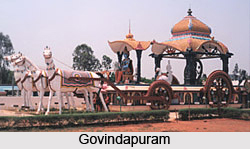Vizianagaram District is one of the northern coastal district of Andhra Pradesh, India. Vizianagaram city is the district head quarter. This district was formed on 1 June 1979, with some parts carved from the neighbouring districts of Vishakhapatnam and Srikakulam. In Telugu Vizia means Victory and Nagaram means city. The district was named after the princely state of Vizianagaram.
History
The history of Vizianagaram was link with Kalinga dynasty. In modern time the upper part of the Kalinga was gradually merged into Orissa and the lower part into Andhra Pradesh. From fourth century B.C it has been ruled by various dynasties .An important event of this district occurred by the war time between the Rajas of Vizianagaram and the Rajas Bobbili, popularly known as Bobbili yuddam on the 24th January 1757.
The war between French and British at Chandurthi in 1758 also counted as a historical point for the formation of Vizianagaram. In 1794 the Vizigapatnam was arranged into three divisions, each under a collector. The present areas of Vizianagaram came under the second division. How ever later all the three divisions were merged and a collectorate for the whole district was established in the year 1803 after the permanent settlement of the area.
The history of the rebellion against British rule goes back to the year 1830s when the people of the districts especially tribals did not able to bear the suppression. Gradually from all parts of the district took part in Indian freedom movements.
After the demolition of Zamindars in the year 1948, Vishakhapatnam district was used for administrative purposes. Consequently Srikakulum was separated and formed a new district of its own in the year 1950.
Vizianagaram district was formed on 1 June 1979, as per G.O.Ms. No.700/Revenue (U) Department dated 15th may with some parts of Srikakulum and Vishakhapatnam districts. The Taluks of Vizianagaram, Gajapathinagaram, Srungavarapukota and a portion of Bheemunipatanam Taluk were transferred in to new district. The Salur, Bobbili, Parvathipuram and Chipurupalli Taluks from Srikakulum districts were added to the new district of Vizianagaram.
 Geography
Geography
This district is situated in the geographical area of 17°-15`and 19°-15` of the Northern latitude and 83°-00`and 83°-45` of the Eastern longitude.
Vizianagaram bounded in east by Srikakulum district. Southern and western part are bounded by Vishakhapatnam. Bay of Bengal is in the southeast part and in northwest is bounded by Orissa.
The total area of the district is 6,30,038 hectors. About 51.1% of the land area is used for agriculture and another 12.3% land is put under non-agricultural uses.17.8% covered by forests and 12.3% of the land is Barren and uncultivable.
The principal rivers are flowing in this district are Nagavali, Suvarnamukhi, Vegavati, Champavati, Gosthani and Kandivalasa.
The climate of Vizianagaram is hot and humidity level is very high with good seasonal rainfall through out the year. The normal rainfall of the district for the year is 1,131.0 mm.
The district can be divided into two distinct natural divisions.i.e, Plains and Hilly areas. The hilly area covers Pachipenta and Gummalaxmipuram mandals and Salur, Makkuva, Ramabhadrapuram, Pavarthipuram and Komarada mandals. The rest areas are plains. The average heights of the hills are 914 meter, although there are several peaks of 1,219 meters high.
Economy
Vizianagaram is prominently an agricultural district as 68.4% of the workers engaged in agriculture. Generally 82% of the population lives in rural areas and depends on agriculture only. 80% of the cultivation is done under rain fed conditions. Even the irrigated area is also depends on the rainfall. Hence the majority of the crops grown are dried crops. Paddy crop is cultivated mainly during Kharif season with 80% of the area under tanks, which in turn depends on rainfall. The major crops are grown are Paddy, Mesta, Groundnut, Ragi, Bajra, Cotton, Sugarcane and Pulses.
There are no major irrigation projects in the district. Because irregation projects are also depends on raining. Only 12 medium irrigation projects are working with 43,984 hectors of land and other minor 1,065 irrigation sources have 51,215 hectors, and 8,616 minor irrigation Tanks with 72,112 hectors of land.
The industrial development in this district are generally agriculture based and consists of Jute mills, Sugar factories, Rice and oil mills and Tiles manufacturing units. The minerals deposited are utilized by the FACOR (The Ferro Alloys Corporation Limited) and other industries. There are 520 factories registered under the factory act in 2005 in the district employment about 27,800 workers.
Nationalized banks, Private and cooperative banks are operating in the district from 148 branches. State Bank Of India with 29mbrances and Andhra bank with 14 branches are leading in the state. S.V. Grameena bank with 56 branches, and Vizianagaram district cooperative Central banks are the leading cooperative banks in thr Vizianagaram district.
Government and Politics
A collector, who is belonging to an officer of Indian Administrative Service, is the head of the Vizianagaram District. He is assisted by one Deputy Collector is also appointed to assist collector.
The Superintendent of police, an officer belonging to the Indian Police Service, is responsible for the maintaining law and order and related issues in the district.
Transport
By Air
Vishakhapatnam is the nearest airport to reach Vizianagaram.
By Rail
Railway network in the entire district comes under Waltair division of the East Coast Railway, Indian Railways. Vizianagaram and Kothavalasa are the main railway junctions. There are also 28 railway stations in the entire district.
By Road
National Highway 5 and 43 runs almost entirely in Vizianagaram district.
Andhra Pradesh State Road Transport Corporation (APSRTC) is the major transport system operated by fleet of buses. There are four bus depots at Vizianagaram, Parvathipuram, Srugavarapukota and Salur.
Divisions
There are 12 assembly and two parliamentary constituencies in Vizianagaram district. The parliamentary constituencies are Bobilli and Parvathipuram. The assembly constituencies are Bhogapuram, Bobbili, Cheepurupalli, Gajapathinagaram, Naguru, Parvathipuram, Salur, Sathivada, Shrungavarapukota, Therlam, Uttarapalli, and Vizianagaram.
There are two Revenue divisions,34 Mandals, 935 Panchayat, 1,551 revenue villages in Vizianagaram.
Demographics
As per 2001 Census, the population of Vizianagaram is 22,49,254. they consists of 11,19,541 males and 11,29,713 females. There are 1009 females per 1000 males in the district.
 Culture
Culture
The social customs in Vizianagaram district are mainly South Indian style. The local people are soft spoken with strong family traditions.
Prominent religion is Hinduism. The major festivals are Shankranti, Ugadi, Rama Navami, Maha Sivratri, Deepavali, Ganesh Chaturthi, Dussehra and Vijayadashmi. The nine -day celebration of Ramnavami and Ganesh Chaturthi is very popular in several towns associated with many cultural events including stage programmes, dramas and Harikatha.
Festivals of Gramdevatha are held annually at Vizianagaram. The most popular is the Pydithalli Ammavari Yatra, is celebrated in Vizianagaram on Vijayadashmi.
Visiting places of Vizianagaram
Paiditalli Ammavari Kovela temple is very famous in Vizianagaram. The Vizianagaram town is full of forts and the Ghantastambham (the clock tower) is also a popular place.
Ramatheertham is hundred-years-old temple of Lord Rama. The temple situated in Bavlikonda Hill. The unique feature of the temple is that it is built entirely upon a huge rock. Near the temple there is a beautiful lake called Koneru Lake, which is built by Pusapati King during 1650-1696A.D.
Near by temple there is also a hill known as Gurubukhatakonda, where we can find the remains enormous Buddhist Mahasthupa, 19 feet high and 65-meter diameter, a monastery.
 Kumili is famous for its 13 temples and well-organized streets. It is only 12kilometer from the town.
Kumili is famous for its 13 temples and well-organized streets. It is only 12kilometer from the town.
Bobbili is a town with historical significance. The fort in the town is the popular destination of tourists. Veena, the musical instrument is also built in this region.
Thotapall is famous for Sri Venkateshwara temple and Shri Ram Temple on the bank of river Nagavali. This place is also famous for its reservoir built in 1903.
 Govindapuram is famous for its magnificent temple, which is renowned for its sculptural beauty based on the essence of Bhagavad Gita. Gyana Ratham with Lord Krishna on the chariot is an impressive image. It is twenty kilometer away from Vizianagaram.
Govindapuram is famous for its magnificent temple, which is renowned for its sculptural beauty based on the essence of Bhagavad Gita. Gyana Ratham with Lord Krishna on the chariot is an impressive image. It is twenty kilometer away from Vizianagaram.
Flora and Fauna
Forest plays an important role in the economy of Vizianagaram. The types of forests are found here are-1. Southern tropical forests 2. Northern Tropical Dry Forests. 3.Southern Tropical Dry Forests. 4.Dry Deciduous Green Forests. 5. Evergreen Forests.
The principal animals here are Yellow bat, Sloth bear, Wild Buffaloes, Fox, Hare, Hyena, Jackal, Mangoos.
Education
Vizianagaram is comparatively backward in the field of Education. The literacy rate is 51.82% as against the average of 61.55% for the entire Andhra State.
There are 2379 Primary schools, 452 Primary schools and 341 High Schools in 2004-2005. there are 81 Junior and 33 Degree Collages. There are 14 Industrial Training Institutes and two Polytechnic Colleges. There are nine B.Ed Colleges and one M.Ed College. One Sanskrit College and Music and Dance College is also present here. There is a Postgraduate Center, five Engineering Colleges, two Law Colleges and a Medical College in Vizianagaram district..
There are 38 branch libraries in the district managed by Zilla Granthalaya Samstha. There are also 41 book depot centers in the district.
Sports
The Maharajkumar of Vizianagaram is known as Sir Vizzy, who popularized the cricket game in the coastal Andhra Pradesh. The Vizzy stadium is one of the cricket grounds in Andhra Pradesh, where international cricket is played.






